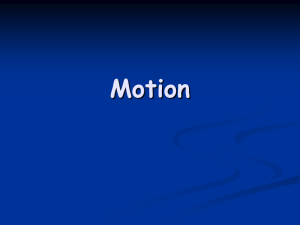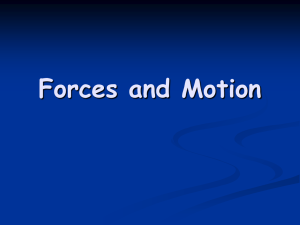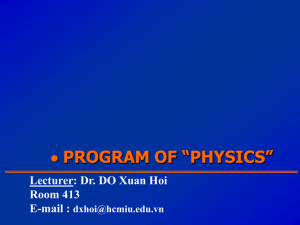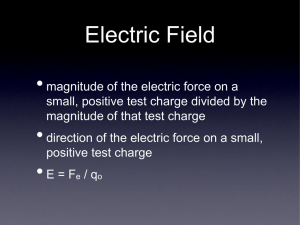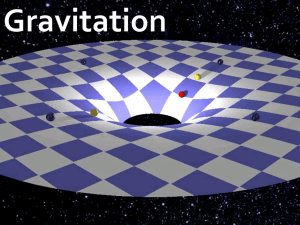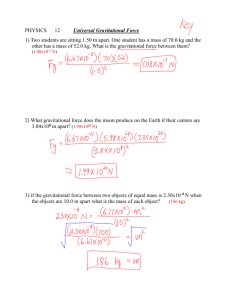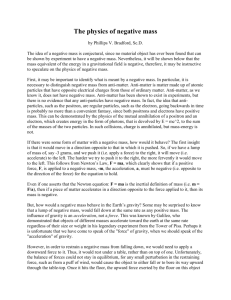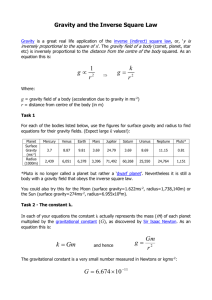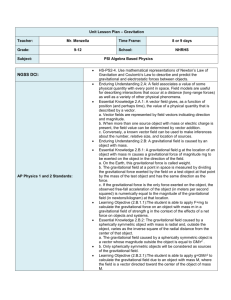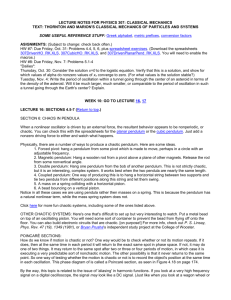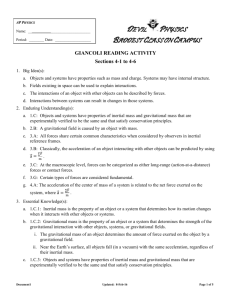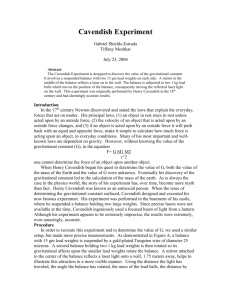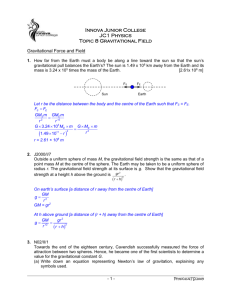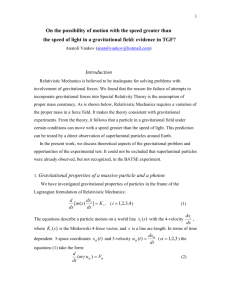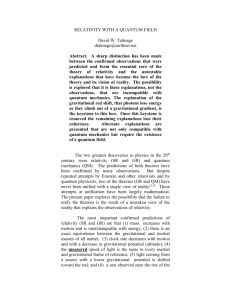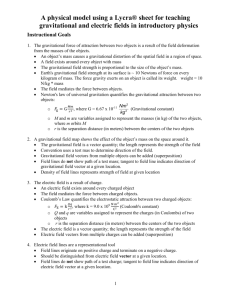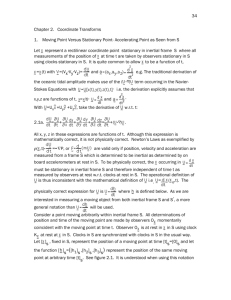What is the mathematical expression that describes the gravitational
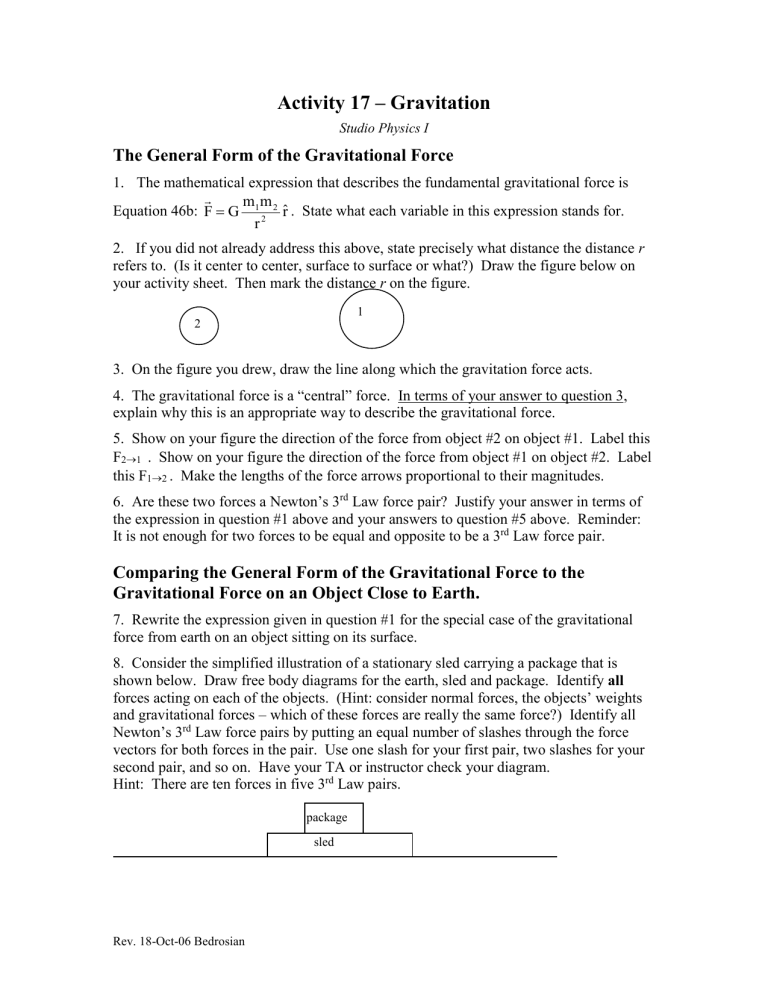
Activity 17 – Gravitation
Studio Physics I
The General Form of the Gravitational Force
1. The mathematical expression that describes the fundamental gravitational force is
Equation 46b:
F
G m
1 r
2 m
2 rˆ . State what each variable in this expression stands for.
2.
If you did not already address this above, state precisely what distance the distance r refers to. (Is it center to center, surface to surface or what?) Draw the figure below on your activity sheet. Then mark the distance r on the figure.
2
1
3. On the figure you drew, draw the line along which the gravitation force acts.
4. The gravitational force is a “central” force. In terms of your answer to question 3, explain why this is an appropriate way to describe the gravitational force.
5. Show on your figure the direction of the force from object #2 on object #1. Label this
F
2
1
. Show on your figure the direction of the force from object #1 on object #2. Label this F
1
2
. Make the lengths of the force arrows proportional to their magnitudes.
6. Are these two forces a Newton’s 3 rd Law force pair? Justify your answer in terms of the expression in question #1 above and your answers to question #5 above. Reminder:
It is not enough for two forces to be equal and opposite to be a 3 rd
Law force pair.
Comparing the General Form of the Gravitational Force to the
Gravitational Force on an Object Close to Earth.
7. Rewrite the expression given in question #1 for the special case of the gravitational force from earth on an object sitting on its surface.
8. Consider the simplified illustration of a stationary sled carrying a package that is shown below. Draw free body diagrams for the earth, sled and package. Identify all forces acting on each of the objects. (Hint: consider normal forces, the objects’ weights and gravitational forces – which of these forces are really the same force?) Identify all
Newton’s 3 rd Law force pairs by putting an equal number of slashes through the force vectors for both forces in the pair. Use one slash for your first pair, two slashes for your second pair, and so on. Have your TA or instructor check your diagram.
Hint: There are ten forces in five 3 rd
Law pairs. package sled
Rev. 18-Oct-06 Bedrosian
9. We are so familiar with the gravitational force from the earth on objects near its surface that we have given this specific case of the fundamental gravitational force a special name. We call it an object’s weight. An object's weight near earth is given by
W=mg where m is the object’s mass and g is the acceleration due to gravity close to the earth. Compare this expression to Equation 46 (a or b) and derive an expression for the acceleration due to gravity on the surface of the earth in terms of the variables and constants used in Equation 46. (Hint: We did this in the lecture.)
10. The gravitational constant G is 6.67 × 10 -11
N
m
2
/kg
2
, the mass of the earth M is
5.98 × 10 24
kg and the radius of the earth R is 6.37 × 10
6
m. Using these values, find the acceleration due to gravity at the surface of the earth. What is your answer for 8850 meters above the earth’s surface (Mt. Everest)? What is your answer for 100 km above the surface (low orbit)? Use three significant digits for your answers.
11. Consider the following two statements. Explain what is correct and what is incorrect about both statements.
Student A: “An object thrown up into the air does not experience a constant downward acceleration because the acceleration due to gravity changes with height above the earth.”
Student B: “No way. The acceleration due to gravity is totally a constant.”
Exercise: Using the Gravitational Force Law in Calculations
12. What is the gravitational force of attraction between two people who are 2 meters apart? Take the mass of each person to be 70 kg. Will they feel this force?
13. Consider the three objects shown below. Copy the figure to your paper. Draw three arrows which show the direction of the gravitational force on object 2 due to object 1, the direction of the force on object 2 due to object 3 and the direction of the net force on object 2.
1
2 3
14. The center-to-center distance between object 1 and object 2 above is 30 cm. The center-to-center distance between object 3 and object 2 is 50 cm. The triangle formed by the three objects has a right angle at object 2. Object 1 has a mass of 0.5 kg, object 2 has a mass of 1 kg and object 3 has a mass of 1.5 kg. Let +X be to the right and +Y up on the page. What is the X component of the net force on object 2? What is the direction (right or left) of the X component? What is the Y component of the net force on object 2?
What is the direction (up or down) of the Y component? What is the magnitude of the net force acting on object 2? What angle does the net force on object 2 make relative to the +X axis?
Rev. 18-Oct-06 Bedrosian


